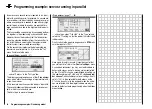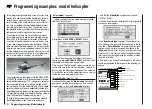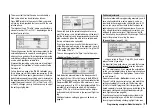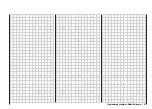
110
Trainer/student
Total control transfer
mx-16s as Student transmitter
The model to be controlled by the pupil must be pro-
grammed completely in a model memory of the Teacher
transmitter, i.e. with all its functions including trims and
any mixer functions.
The control functions of the Student transmitter must act
directly on the control channels, i.e. the receiver outputs,
without the intervention of any mixers. To accomplish
this it is best to set up a empty model memory in the Pu-
pil transmitter with the required model type (“Fixed-wing”
or “Helicopter”). Assign the model name “STUDENT”,
and set up the stick mode (Mode 1 … 4) and “Idle front /
rear” to suit the pupil’s preference. All the other settings
should be left at the appropriate default values. If you
select the “Helicopter” model type, the throttle / collective
pitch direction and idle trim must also be set accordingly
on the Pupil transmitter. All other functions are carried
out by the Teacher transmitter.
Important:
The Student transmitter must always be set to PPM
transmission, regardless of the modulation selected
at the Teacher transmitter. However,
always
leave the
On / Off switch on the Pupil transmitter at the
“OFF”
position, as this is the only way to ensure that an
RF signal is not radiated by the transmitter module,
even when the DSC lead is plugged in. At the basic
display of the transmitter the message
“DSC”
will
appear instead of the display of the selected trans-
mission channel.
mx-16s as Teacher transmitter (total control transfer)
The model to be controlled by the pupil must be pro-
grammed completely in a model memory of the Teacher
transmitter, i.e. with all its functions including trims and
any mixer functions. The two transmitters should now be
connected together using the appropriate Trainer lead:
see the diagram on the right-hand page.
Total control transfer is the only option when using the
mx-16s transmitter with a Pupil transmitter.
If you are using a Trainer lead with the Order No.
3290.7
or
3290.8
, connect the plug marked “
M
” (“Master”) to the
socket on the Teacher transmitter, and the plug marked
“
S
” (“Student” or “Slave”) to the socket of the Pupil trans-
mitter. Both transmitters must be prepared as described
in the operating instructions supplied with them.
Select the “trainer/student” line in the »
Base
settings
«
menu, and assign a Trainer change-over switch. Ideal-
ly this should be the momentary button SW 4 / PB 8,
assigned as “push-button 8” (see page 25), so that the
fl ight tutor can instantly resume control from the Teacher
transmitter at any time.
Channel
Function
1
Throttle / brake or Collective pitch
2
Aileron or Roll-axis
3
Elevator or Nick-axis
4
Rudder / Tail rotor
Trainer system
The two transmitters should now be connected together
using the appropriate Trainer lead: see the diagram on
the right-hand page.
When assigning the control functions the usual conventi-
on should be observed:
As long as this button is held pressed in, the system is
in Pupil mode. As soon as the button is released, the
Teacher transmitter resumes full control.
The basic display of the mx-16s Teacher transmitter
does not change when Pupil mode is selected.
Checking the functions
Operate the assigned Trainer change-over switch:
•
The Student system is working properly if no error
message appears in the basic display of the Teacher
transmitter when you operate the assigned change-
over switch.
•
However, if the basic display shows the message …
· … then there is a problem with the connection. At the
same time you will hear a warning signal. In this case
all the functions remain under the control of the Tea-
cher transmitter, regardless of the position of the Trai-
ner change-over switch; this ensures that the model
is not uncontrollable at any time.
Important note:
It is absolutely essential to check that all functions
are transferred correctly BEFORE you start using a
Trainer mode system.
Summary of Contents for MX-16S
Page 1: ...1...
Page 17: ...17...
Page 31: ...31 Fixed wing models Installation and connections...
Page 35: ...35 Program description Reserving a new memory...
Page 47: ...47 Base settings Model helicopter...
Page 83: ...83 Fail safe...
Page 89: ...89 Programming examples Fixed wing model...
Page 109: ...109 Programming examples Model helicopter...
Page 112: ...112 112...
Page 116: ...116...







































